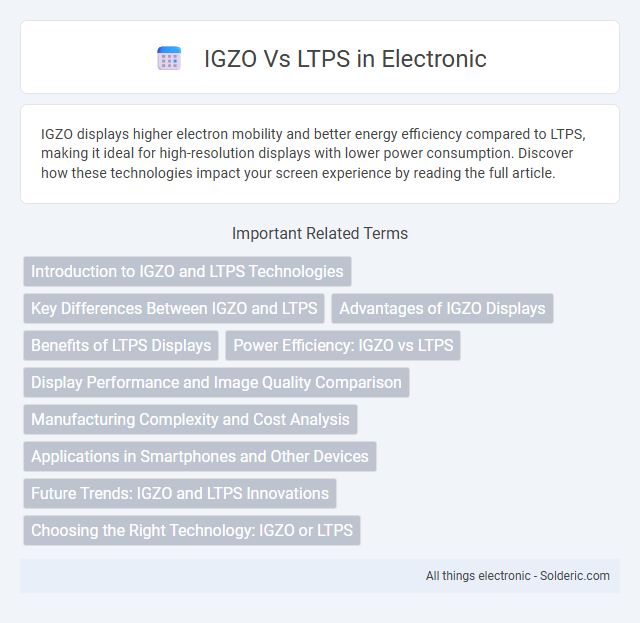IGZO displays higher electron mobility and better energy efficiency compared to LTPS, making it ideal for high-resolution displays with lower power consumption. Discover how these technologies impact your screen experience by reading the full article.
Comparison Table
| Feature | IGZO (Indium Gallium Zinc Oxide) | LTPS (Low Temperature Polycrystalline Silicon) |
|---|---|---|
| Technology Type | Oxide semiconductor thin-film transistor (TFT) | Polycrystalline silicon TFT |
| Electron Mobility | 10-20 cm2/V*s (moderate) | 100-200 cm2/V*s (high) |
| Resolution Support | High resolution, suitable for 4K and beyond | Very high resolution, excellent for mobile displays |
| Power Efficiency | Low power consumption due to higher electron mobility than a-Si | Higher power consumption compared to IGZO |
| Manufacturing Cost | Moderate, emerging technology | Higher cost due to complex process |
| Material Transparency | High transparency, enabling brighter displays | Low transparency |
| Ideal Applications | Large-area displays, TVs, monitors | Smartphones, high-resolution small to medium screens |
Introduction to IGZO and LTPS Technologies
IGZO (Indium Gallium Zinc Oxide) and LTPS (Low-Temperature Polycrystalline Silicon) are advanced display technologies used in modern screens. IGZO offers higher electron mobility and lower power consumption, making it ideal for high-resolution displays and energy-efficient devices. LTPS provides superior pixel control and brightness, enhancing your visual experience in smartphones and tablets with sharp imagery and vibrant colors.
Key Differences Between IGZO and LTPS
IGZO (Indium Gallium Zinc Oxide) and LTPS (Low-Temperature Polycrystalline Silicon) are distinct display technologies with key differences in performance and applications. IGZO offers higher electron mobility and better energy efficiency, making it ideal for high-resolution screens with lower power consumption, while LTPS provides superior pixel density and faster response times suitable for smartphones and high-end displays. Your choice between IGZO and LTPS depends on whether energy efficiency or display sharpness is prioritized.
Advantages of IGZO Displays
IGZO displays offer superior energy efficiency due to lower electron mobility, enabling longer battery life for devices compared to LTPS panels. They provide higher pixel density and improved transparency, resulting in sharper images and brighter screens ideal for high-resolution applications. Enhanced stability and reduced image retention make IGZO technology preferable for devices requiring consistent performance over extended use.
Benefits of LTPS Displays
LTPS (Low Temperature Polycrystalline Silicon) displays offer superior electron mobility compared to IGZO (Indium Gallium Zinc Oxide), enabling higher resolution and faster pixel response times. This technology supports higher refresh rates and better power efficiency, making it ideal for smartphones and high-performance devices. LTPS also allows for integrated driver circuits on the glass substrate, reducing overall display size and improving device thinness.
Power Efficiency: IGZO vs LTPS
IGZO displays offer superior power efficiency compared to LTPS due to their lower off-state current and reduced power consumption during standby. This efficiency makes IGZO ideal for devices requiring longer battery life and consistent performance. Your device will benefit from extended usage time with IGZO technology, especially in applications demanding high-resolution and low power draw.
Display Performance and Image Quality Comparison
IGZO technology offers superior display performance with higher electron mobility, enabling faster pixel response times and lower power consumption compared to LTPS. Image quality on IGZO panels typically features more accurate colors and better brightness uniformity, making visuals sharper and more vibrant. Your viewing experience benefits from IGZO's enhanced contrast ratios and improved clarity, especially in high-resolution displays.
Manufacturing Complexity and Cost Analysis
IGZO (Indium Gallium Zinc Oxide) displays feature lower manufacturing complexity due to simpler deposition processes and compatibility with existing LCD fabrication lines, resulting in cost-effective production for mid-range to high-end displays. LTPS (Low-Temperature Polycrystalline Silicon) screens require more intricate manufacturing involving laser annealing and additional steps, increasing production time and expenses, making them preferred for premium smartphones and devices demanding high pixel density. The cost analysis reveals IGZO offers a balance of performance and affordability, while LTPS commands higher costs justified by superior electrical mobility and resolution capabilities.
Applications in Smartphones and Other Devices
IGZO (Indium Gallium Zinc Oxide) displays offer higher pixel density and better energy efficiency, making them ideal for high-resolution smartphone screens and wearable devices requiring longer battery life. LTPS (Low-Temperature Polycrystalline Silicon) technology provides faster electron mobility, delivering superior touch response and brightness in flagship smartphones and tablets. Your choice between IGZO and LTPS impacts device performance, battery consumption, and display clarity depending on specific application needs.
Future Trends: IGZO and LTPS Innovations
IGZO technology is advancing with innovations in higher electron mobility and lower power consumption, making it ideal for ultra-high-resolution displays and flexible electronics. LTPS continues to evolve through improvements in pixel density and integration with OLED panels, enhancing mobile device displays and VR applications. Future trends indicate a convergence of IGZO and LTPS benefits, enabling hybrid displays that combine superior energy efficiency with exceptional image quality.
Choosing the Right Technology: IGZO or LTPS
Choosing the right display technology depends on application needs, where IGZO offers higher electron mobility and better power efficiency for high-resolution screens in smartphones and tablets, while LTPS provides superior pixel density and faster refresh rates ideal for OLED displays in premium devices. IGZO's lower power consumption enables longer battery life, making it suitable for portable electronics, whereas LTPS excels in delivering vibrant colors and sharp image quality necessary for high-end smartphones and laptops. Manufacturers prioritize IGZO for energy-efficient HD panels and LTPS for performance-driven displays requiring rapid response times and enhanced clarity.
IGZO vs LTPS Infographic

 solderic.com
solderic.com